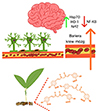Neuroprotective effect of curcumin and its potential use in the treatment of neurodegenerative diseases
DOI:
https://doi.org/10.18388/pb.2021_472Abstract
The development of methods used in molecular biology has allowed a milestone in medical and pharmaceutical sciences. Progress has also been made in the field of pharmacognosy, which places substances of natural origin contained in plant raw materials at the center of attention. The beneficial effects of some of them have been known for years, while scientific evidence of their health-promoting properties was lacking for a long time. This was also the case with curcumin and the long road from its isolation in pure form in 1842 to the knowledge of its chemical structure in 1910. Due to the chemical properties of the molecule, curcumin is attributed with many health-promoting properties. These affect many organ systems including the skin, visual pathway, respiratory system, circulatory system, digestive system and nervous system. One of the complications that follow nerve damage is the loss of locomotor function in the animal and the development of inflammation within it. Curcumin has anti-inflammatory properties. This is confirmed by its inhibition of nuclear factor κB, a mediator in inflammatory processes. In addition, a very important field associated with neuronal dysfunction is the aging process. This is caused, among other things, by the presence of reactive oxygen species. The neuroprotective effect of curcumin allows to reduce their concentration caused by the accumulation of mutations within the mitochondrial DNA. The beneficial effect on the nervous system is due to the penetration of curcumin across the blood-brain barrier. However, its poor solubility significantly limits the therapeutic properties resulting from curcumin supplementation. Methods are currently being developed to increase its bioavailability using nanoparticles.

Published
Issue
Section
License
Copyright (c) 2023 Mikołaj Górka, Natalia Białoń , Dominika Bieczek, Dariusz Górka

This work is licensed under a Creative Commons Attribution 4.0 International License.
All journal contents are distributed under the Creative Commons Attribution-ShareAlike 4.0 International (CC BY-SA 4.0) license. Everybody may use the content following terms: Attribution — You must give appropriate credit, provide a link to the license, and indicate if changes were made, ShareAlike — If you remix, transform, or build upon the material, you must distribute your contributions under the same license as the original. There are no additional restrictions — You may not apply legal terms or technological measures that legally restrict others from doing anything the license permits.
Copyright for all published papers © stays with the authors.
Copyright for the journal: © Polish Biochemical Society.



